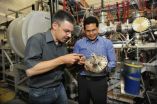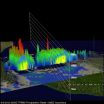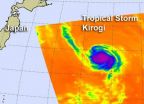(Press-News.org) A large-scale review of national patient records reveals that although survival rates are the same, the cost of treating trauma patients in the western United States is 33 percent higher than the bill for treating similarly injured patients in the Northeast. Overall, treatment costs were lower in the Northeast than anywhere in the United States.
The findings by Johns Hopkins researchers, published in The Journal of Trauma and Acute Care Surgery, suggest that skyrocketing health care costs could be reined in if analysts focus on how caregivers in lower-cost regions manage their patients.
At least in the case of trauma care, "spending more doesn't always mean saving more lives," says study leader Adil H. Haider, M.D., M.P.H., an associate professor of surgery at the Johns Hopkins University School of Medicine and director of Hopkins' Center for Surgical Trials and Outcomes Research. "If doctors in the Northeast do things more economically and with good results, why can't doctors out West do the same thing? This study provides a potential road map for cutting unnecessary costs without hurting outcomes."
But researchers say they don't know exactly why costs vary by region. Haider says that it is possible that in one part of the country, it may be customary to do an expensive type of medical test prior to treatment, while in other parts, that test may not be done.
Haider notes that health care costs account for roughly 16 percent of the Gross Domestic Product (GDP) of the United States, and trauma-related disorders rank among the five most costly conditions.
For their study, Haider and his colleagues analyzed three years of data from the Healthcare Cost and Utilization Project's Nationwide Inpatient Sample (NIS), the largest all-payer inpatient database publicly available in the United States. They identified 62,678 adult patients with a primary injury in one of five domains: blunt injury to the spleen, collapsed lung and bleeding in the chest, shinbone (tibia) fracture, mild traumatic brain injury and liver injury.
After controlling for a variety of factors that could bias the results — including injury severity, the presence of chronic illnesses, variations in regional prices for goods — the researchers estimated that the average per-person cost in the Northeast for trauma care for all five injury types combined was $14,022. The cost was 18 percent higher in the South, 22 percent more in the Midwest and 33 percent more in the West.
Of the injury types, the most expensive was for liver injury. For liver injury, the average cost of care in the Northeast was $16,213, while the cost was 18 percent more in the South, 22 percent more in the Midwest and 35 percent more in the West.
The Northeast also had the lowest costs for each of the five types of injury, while the West had the highest, even after accounting for known differences in the widely used consumer price index.
Haider, a trauma surgeon, cautions that when looking for ways to cut costs, researchers should look closely at outcomes beyond survival alone to make sure the more expensive care isn't better in some way. For example, it may be possible, he says, that higher-cost regions have patients with less pain and fewer disabilities after recovery.
"If surgeons are fixing tibia fractures in the West in a way that's more expensive but makes patients more comfortable, that would not be a trivial finding," Haider says. "We really need to drill down and figure out what parts of care improve outcomes and what parts drive up costs without improving any outcomes or aspects of care important to patients."
###Financial support for this work was provided by: National Institutes of Health/ NIGMS K23GM093112-01; American College of Surgeons C. James Carrico Fellowship for the study of Trauma and Critical Care and Hopkins Center for Health Disparities Solutions.
Other Johns Hopkins researchers involved in the study include Darrell J. Gaskin, Ph.D.; Cassandra V. Villegas, M.D., M.P.H.; Stephen M. Bowman, Ph.D.; Eric B. Schneider, Ph.D.; Elliott R. Haut, M.D.; and David T. Efron, M.D.
For more information:
https://www.hopkinsresearch.org/JHH_Home.aspx
http://www.jhsph.edu/research/centers-and-institutes/johns-hopkins-center-for-health-disparities-solutions/
Spending more on trauma care doesn't translate to higher survival rates
Research finds wide, unexplained regional differences in costs – and clues to where money can be saved
2012-08-10
ELSE PRESS RELEASES FROM THIS DATE:
Stabilizing shell effects in heaviest elements directly measured
2012-08-10
This press release is available in German.
So-called "superheavy" elements owe their very existence exclusively to shell effects within the atomic nucleus. Without this stabilization they would disintegrate in a split second due to the strong repulsion between their many protons. The constituents of an atomic nucleus, the protons and neutrons, organize themselves in shells. Certain "magic" configurations with completely filled shells render the protons and neutrons to be more strongly bound together.
Long-standing theoretical predictions suggest that also in superheavy ...
Team creates new view of body's infection response
2012-08-10
A new 3-D view of the body's response to infection – and the ability to identify proteins involved in the response – could point to novel biomarkers and therapeutic agents for infectious diseases.
Vanderbilt University scientists in multiple disciplines combined magnetic resonance imaging (MRI) and imaging mass spectrometry to visualize the inflammatory response to a bacterial infection in mice. The techniques, described in Cell Host & Microbe and featured on the journal cover, offer opportunities for discovering proteins not previously implicated in the inflammatory response.
Access ...
The earthquake risk and Europe
2012-08-10
How strong can earthquakes in Germany be? Where in Europa are the earthquake activities concentrated? These questions are the basis for risk assessments and become relevant when it comes to the safety of buildings or the generation of tsunami.For the first time, scientists of the GFZ German Research Centre for Geosciences have succeeded in setting up a harmonized catalogue of earthquakes for Europe and the Mediterranean for the last thousand years. This catalogue consists of about 45000 earthquakes, reported in the latest issue of the „Journal of Seismology".
Earthquakes ...
Researchers combine remote sensing technologies for highly detailed look at coastal change
2012-08-10
Athens, Ga. – Shifting sands and tides make it difficult to measure accurately the amount of beach that's available for recreation, development and conservation, but a team of University of Georgia researchers has combined several remote sensing technologies with historical data to create coastal maps with an unsurpassed level of accuracy.
In a study published in the August issue of the journal Tourism Management, they apply their technique to Georgia's Jekyll Island and unveil a new website that allows developers, conservationists and tourists access to maps and data ...
Hepatitis A vaccination in children under 2 remains effective for 10 years
2012-08-10
Vaccination against the hepatitis A virus (HAV) in children two years of age and younger remains effective for at least ten years, according to new research available in the August issue of Hepatology, a journal of the American Association for the Study of Liver Diseases (AASLD). The study found that any transfer of the mother's HAV antibodies does not lower the child's immune response to the vaccine.
The World Health Organization (WHO) estimates that 1.4 million cases of HAV occur worldwide each year. HAV affects the liver and typically occurs in areas with poor sanitation ...
Why living in the moment is impossible
2012-08-10
The sought-after equanimity of "living in the moment" may be impossible, according to neuroscientists who've pinpointed a brain area responsible for using past decisions and outcomes to guide future behavior. The study, based on research conducted at the University of Pittsburgh and published today in the professional journal Neuron, is the first of its kind to analyze signals associated with metacognition—a person's ability to monitor and control cognition (a term cleverly described by researchers as "thinking about thinking.")
"The brain has to keep track of decisions ...
Freezing magnetic monopoles
2012-08-10
Magnetic monopoles, entities with isolated north or south magnetic poles, weren't supposed to exist. If you try to saw a bar magnet in half, all you succeed in getting are two magnets, each with a south and north pole. In recent years, however, the existence of monopoles, at least in the form of "quasiparticles" consisting of collective excitations among many atoms, has been predicted and demonstrated in the lab. Now Stephen Powell, a scientist at the Joint Quantum Institute (JQI*) and the University of Maryland, has sharpened the theoretical framework under which ...
NASA sees very heavy rainfall within Tropical Storm Ernesto
2012-08-10
NASA's Tropical Rainfall Measuring Mission satellite, known as TRMM can measure the rate rain is falling with a tropical cyclone from its orbit in space, and data from August 9 reveals areas of heavy rainfall in Tropical Storm Ernesto as it heads for a second landfall in Mexico.
The TRMM satellite saw tropical storm Ernesto on August 9, 2012 at 0656 UTC (2:36 a.m. EDT) after it moved from the Yucatan Peninsula into the Gulf of Mexico. An analysis of TRMM Microwave Imager (TMI) and Precipitation Radar (PR) rainfall shows that powerful convective thunderstorms were dropping ...
NASA sees Tropical Storm Kirogi headed for cooler waters
2012-08-10
Sea surface temperatures cooler than 80 degrees Fahrenheit can sap the strength from a tropical cyclone and Tropical Storm Kirogi is headed toward waters below that threshold on its track through the northwestern Pacific Ocean, according to data from NASA's Aqua satellite.
NASA's Aqua satellite passed over Tropical Storm Kirogi on August 9 at 0241 UTC. The Atmospheric Infrared Sounder (AIRS) instrument captured an infrared image of the cloud temperatures that showed a concentrated area of strongest storms and heaviest rainfall west of the center of circulation. Vertical ...
Height, weight and BMI changes seen in children treated with peginterferon alpha for hepatitis C
2012-08-10
Follow-up research from the Pediatric Study of Hepatitis C (PEDS-C) trial reveals that children treated with peginterferon alpha (pegIFNα) for hepatitis C (HCV) display significant changes in height, weight, body mass index (BMI), and body composition. Results appearing in the August issue of Hepatology, a journal of the American Association for the Study of Liver Diseases, indicate that most growth-related side effects are reversible with cessation of therapy. However, in many children the height-for-age score had not returned to baseline two years after stopping ...
LAST 30 PRESS RELEASES:
Air pollution exposure and birth weight
Obstructive sleep apnea risk and mental health conditions among older adults
How talking slows eye movements behind the wheel
The Ceramic Society of Japan’s Oxoate Ceramics Research Association launches new international book project
Heart-brain connection: international study reveals the role of the vagus nerve in keeping the heart young
Researchers identify Rb1 as a predictive biomarker for a new therapeutic strategy in some breast cancers
Survey reveals ethical gaps slowing AI adoption in pediatric surgery
Stimulant ADHD medications work differently than thought
AI overestimates how smart people are, according to HSE economists
HSE researchers create genome-wide map of quadruplexes
Scientists boost cell "powerhouses" to burn more calories
Automatic label checking: The missing step in making reliable medical AI
Low daily alcohol intake linked to 50% heightened mouth cancer risk in India
American Meteorological Society announces Rick Spinrad as 2026 President-Elect
Biomass-based carbon capture spotlighted in newly released global climate webinar recording
Illuminating invisible nano pollutants: advanced bioimaging tracks the full journey of emerging nanoscale contaminants in living systems
How does age affect recovery from spinal cord injury?
Novel AI tool offers prognosis for patients with head and neck cancer
Fathers’ microplastic exposure tied to their children’s metabolic problems
Research validates laboratory model for studying high-grade serous ovarian cancer
SIR 2026 delivers transformative breakthroughs in minimally invasive medicine to improve patient care
Stem Cell Reports most downloaded papers of 2025 highlight the breadth and impact of stem cell research
Oxford-led study estimates NHS spends around 3% of its primary and secondary care budget on the health impacts of heat and cold in England
A researcher’s long quest leads to a smart composite breakthrough
Urban wild bees act as “microbial sensors” of city health.
New study finds where you live affects recovery after a hip fracture
Forecasting the impact of fully automated vehicle adoption on US road traffic injuries
Alcohol-related hospitalizations from 2016 to 2022
Semaglutide and hospitalizations in patients with obesity and established cardiovascular disease
Researchers ‘listen in’ to embryo-mother interactions during implantation using a culture system replicating the womb lining
[Press-News.org] Spending more on trauma care doesn't translate to higher survival ratesResearch finds wide, unexplained regional differences in costs – and clues to where money can be saved




